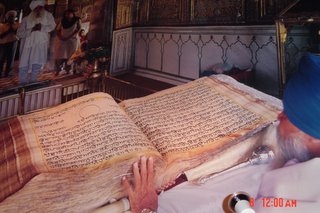Golden Temple

Originally during 1574, the site of the temple was surrounded by a small lake, in a thin forest. The lake was enlarged and a small township was established during the leadership of the fourth Sikh Guru (Guru Ram Das, 1574-1581). It was during the leadership of the fifth Guru (Guru Arjan, 1581-1606), that full fledged Temple was built. The land on which it was built was gifted to Guru Ram Das by the Mughal emperor Akbar. A Muslim saint Hazrat Mian Mir of Lahore in December 1588 initiated the construction of the building by laying the foundation stone. It was completed in 1601. The temple was later attacked and had to be substantially rebuilt in the 1760s.

Amritsar is one of the most ancient and legendary sites in the Punjab. The origin of the place where the Sri Hari Mandir stands is shrouded in mystery. Some trace its origin to the pre-historic, Vedic-epic period as a place of considerable religious importance in the form of a Amrit Kund (Spring of Nectar). But the site seems to have lost its eminence under the sway of the Buddhist movement, which swept away most of the important Hindu holy places. According to popular belief – Valmiki wrote his celebrated epic, the Ramayana, near around this hallowed site of the "Pool of Nectar". It was here, too, that Sita stayed during the period of her vanavasa (banishment). Here again, the twin sons of Lord Rama, were taught the Ramayana. Yet another legend identifies the site of this pool with the place where the whole of Lord Rama's army was destroyed by his sons, Lava and Kusa, and relates how at that time a jug of nectar descended from heaven to restore the soldiers to life.

Valmiki's ashram, it is said, lay within a short distance of the renowned "Pool of Nectar". In Valmiki's time, the area was a thick forest. There were around Valmiki's ashram some more tanks with historical associations. One such hexagonal tank, Ram Tirth, is at a distance of around 1.1 kilometres from Amritsar; the others are Ramsar, Santokhsar, Ram Talai and Durgiana. Guru Ram Das must have known-the legendary importance of the place when he sanctified the pool of nectar in the sixteenth century.
The temple is surrounded by a pool of water, known as the Sarovar. There are four entrances to the temple, signifying the importance of acceptance and openness. Anyone who wants to enter the Golden Temple may do so, irrespective of religion, colour, creed or sex.




0 Comments:
Post a Comment
Subscribe to Post Comments [Atom]
<< Home